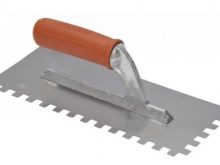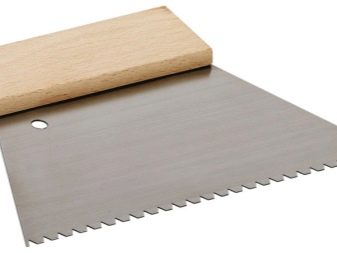Comb for tile: the subtleties of choice
High-quality tiles can please the owners with their beautiful appearance for many years. Therefore, it is important to lay the material according to all the rules so that the finish will not be deformed in the future.
Finishing works, as a rule, take not too much time and physical strength, especially if performed with the help of the right tools. In addition to the usual spatula, you will need a comb for the tile, the subtleties of the choice of which you need to know before purchasing it.
What is a notched trowel
The process of laying tiles begins with the application of glue to the cladding surface. These manipulations are carried out with a standard construction spatula, but in order to remove an excess amount of adhesive solution, a special comb with teeth is needed. This tool allows you to distribute the required volume of the coupling solution over the surface. After pressing the decoration plates to the place of installation, the glue evenly fills the required space.
Through such actions, the material is securely fixed to the surface.
If mounted on a wall, you can be sure that the tile will not fall off. If laying is done on the floor, then when heavy objects fall, no holes will appear on it, although cracks may form on the upper layer of the tile.
Using a comb for tile has many advantages:
- Laying is reliable and high-quality, as the adhesive mixture is distributed in the same layer over the entire surface. The main condition - the base should not be defective.
- The pace of work is significantly accelerated, since additional time is not wasted to displace the glue and remove its excess.
- The adhesive solution is consumed in the optimal amount. A notched trowel helps to use exactly as much glue as the instruction provides. Therefore, you can not worry about the overrun of the mixture and, accordingly, about the extra material costs.
Species
There is an erroneous opinion that the comb is not the most important inventory in facing works.Many are also sure that the glue can be applied with a conventional tool without teeth, which are not of fundamental importance. And with this we can argue, because the quality of the result of work depends directly on the devices used.
Modern manufacturers produce a variety of combs. They differ not only in shape, but also in the material of manufacture. Experts advise not to chase cheap, and buy a good tool. When choosing it is important to pay attention to several important factors:
- Quality comb, usually made from stainless steel. This material does not allow the tool to be deformed during work, which means that the installation will be carried out without any unpleasant moments. Laying a tile with such spatulas is more convenient because of their rigidity.
- Some manufacturers produce a comb from plastic. Such a tool is certainly much cheaper, but it breaks much more often. After a few minutes of facing work, you can see that the teeth are erased, and in some places even fall out. In addition, a plastic tool bends easily, which negatively affects the quality of work.
- Also combs differ in shape and the presence of the handle. Available in models with a handle fixed directly on the work surface. Also on sale are notched spatulas with a handle located perpendicular to the working plane. It is only experimentally possible to understand which type of comb is better to choose, although professionals are inclined to purchase the first option. In their opinion, working with such a tool is much more convenient. The size of the trowel varies from 10 to 45 cm.
Teeth shape
There are products with square, semicircular and triangular teeth. Accordingly, depending on this criterion, each comb must have a marking with a number:
- For example, the designation A1 indicates the triangular shape of the teeth and the small length of the spaces between them. Such a tool should be chosen if you have to work with mobile solutions or need to apply a thin layer of glue (no more than 5 mm).
- The comb with square teeth is suitable for applying mortar up to 12 mm high. This option is ideal for mounting wall tiles.
- The tool with semicircular teeth is necessary for working with synthetic substances or for applying adhesivemasses with a layer height greater than 12 mm.
Laying floor tiles from PVC is better to produce a comb A2 or B1.
Also for facing works, the size of the teeth of the device used is also important. There are several standard options available:
- 4x4 mm. Such tools are used exclusively for the installation of mosaic tiles or tiles with a side size not exceeding 10 cm (and only with a smooth back side). This comb provides a minimum consumption of adhesive.
- 6x6 mm. This option is the ideal choice for facing the surface of tiles 20x20 cm. Suitable tool with the size of teeth and for lining works on the floor and walls. It can also be used for laying tiles 10x10 cm, if there are grooves on the back side of the decorative material. When applying the adhesive with such a spatula, 3 kg of the mix is consumed per 1 m2.
- 10x10 mm and 12x12 mm. Such combs are bought for laying facing tiles with a size of 30x30 cm and a thickness of not more than 1 cm. In this case, the amount of glue can be up to 4.5 kg per 1 m2.
- Combs with rounded grooves up to 20 mm height used when installing heavy large tiles or marble slabs.The glue consumption here reaches 9 kg per 1 m2.
Professional Tips
To an inexperienced tiler it may seem that there is no significant difference between the dies. Visually, they often differ only in the color of the handle and the place of its fasteners. However, a situation may arise in a store when tools that are absolutely identical in terms of external characteristics have a different price. Sellers can argue this fact that the high cost is due to the material of the handle and the method of its fastening, but this moment should worry the buyer least of all.
In the process of laying tiles handle spatula does not actively participate, but the teeth can be deformed. With intensive work, the difference between the height of the extreme and middle teeth can reach 3 mm or more.
Therefore, it is important to find out from which material the working surface of the tool is made. Before leaving the store with a purchase, you must also hold the tool and make sure that it will be convenient to work with the selected model. The handle should fit comfortably in your hand and be easy to hold.
Professionals prefer to work with lacquered holders.According to the master-tilers, such pens are more practical. They do not slip and do not leave splinters in the skin, as can occur with wooden specimens.
Plastic holders can also be used, but if you work without gloves, such a handle can rub the corns.
To learn how to make a comb for a quick tile-do-it-yourself, see the next video.











































